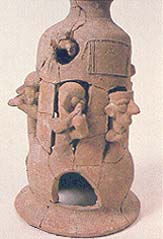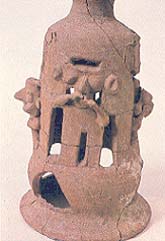020
Archaeologists are gradually recovering the remains of musical life from ancient Israel. More than three hundred remains of actual instruments and representations of musical scenes have been recorded. The dates of these items range from late pre-history to the Byzantine period, including a sizable number within the span from Biblical to Second Temple times, roughly 1,000 B.C. to the first century A.D.
Not long ago, these were “The Finds That Could Not Be.” In the 1940’s and 1950’s, an astonishing “consensus of nonexistence” came about, through several influential publications. As late as 1957, one of these stated:
“Of the instruments themselves [of Biblical times] not a single example has as yet come to light, and from the pre-Hellenistic period no native representation of a Palestinian instrument survives.”1
An earlier survey, Musical Instruments in Israel (published in 1941 and reissued in 1961) gave reasons for this state of affairs:
“Due to the climate of the Holy Land, all the wood, reed, hide and gut which went into the ancient instruments long ago has disintegrated; and sculptured scenes showing musicians, which have taught us so much about the instrumentalists of Babylonia and Egypt, were forbidden by the Second Commandment.a
Consequently, our knowledge of the instruments which stirred or entertained the ancient Israelites must come almost entirely from the literary references, comparisons with known instruments in the surrounding nations, and analogies with present Palestinian instruments which seem to be survivals from antiquity.“2
Curiously enough, in 1941 this very article was illustrated not only by items from Egypt and Mesopotamia but also by photographs of three then-recent finds from Israel: cymbals from Beth Shemesh, the handle of a sistrum (Egyptian rattling instrument) from Beth El, and a painted vessel with lyre player from Megiddo. The text also mentions pottery rattles from Tell Beit Mirsim. In the 1961 version of this survey, illustration space was more limited, so none of the examples from Israel was published. What had been visible—in spite of what the text itself said—again disappeared.
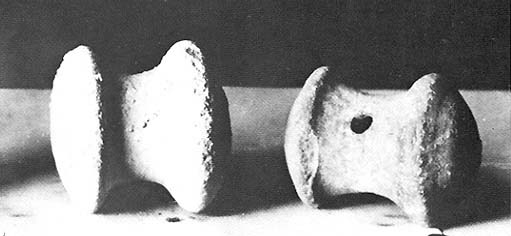
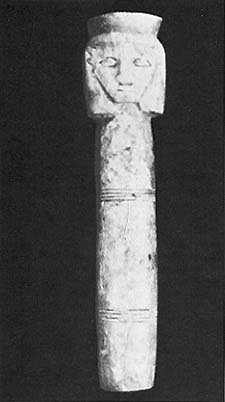
022
The evidence makes it hard to understand how such inaccurate statements could be repeated again and again, even in the 1940’s and 1950’s. Firstly, quite a number of finds had already been published by that time. Secondly, organic materials like reed, hide, and gut have survived in some regions of the country. Moreover, instruments were also made from pottery, bone, ivory, and metals. Thirdly, it was already known that the second commandment was not strictly observed throughout the “Biblical” period. Finally, how could scholars compare the “known instruments” from “surrounding nations” (such as Egypt and Mesopotamia) with the “non-existent” Biblical instruments? How could one tell which “present Palestinian instruments” were survivals from antiquity? As we shall see in this article and the accompanying illustrations, archaeological discoveries amply demonstrate a clear record of musical life in ancient Israel.
In 1963, I published the first inventory, culled from excavation reports, of musically relevant archaeological artifacts from Israel. At that time, the inventory already 023contained more than 250 items.3 My project—to catalog and interpret this material—has continued since then. Each year brings new finds which often stimulate new insights and modify previous conclusions.
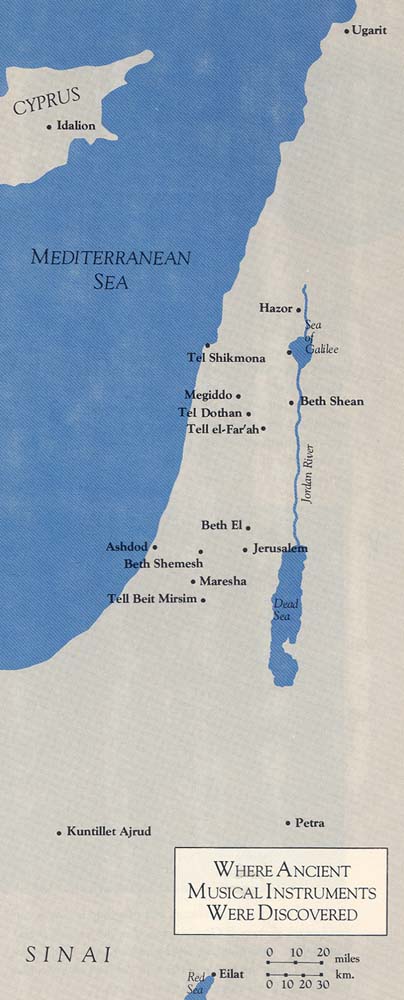
It is true that some musical objects have a lower chance of survival than others. Since the soil in most parts of Israel is not kind to organic materials such as gut or skin or wood, it is not surprising that we have not yet found a stringed instrument or drum relic. Wind instruments made entirely of wood or cane have not been found either, though the dry Judean desert and the Negev may someday yield even these. If scrolls, sandals, and ropes have been recovered—why not a reed-flute, a drum, or even a lyre? (A reed mouthpiece is said to have been found during Nelson Glueck’s excavations near Eilat, but I have not been able to see it.) The possibility of survival of such instruments, from as early as the period of the Monarchy, has been confirmed by recent discoveries of organic materials at Kuntillet Ajrud, an eighth-century B.C. site in the southern Negev. Fragments of linen and 024wool, dried pomegranates, and a sieve made of woven tendons and palm fibers were found there in remarkable condition. (See “Did Yahweh Have a Consort?” BAR 05:02, by Ze’ev Meshel).
Metals have a better chance of survival than organic materials. Bronze, iron, gold, and silver were definitely used for entire instruments, or certain parts or decorations on them, while copper was rarely used for musical instruments. More than a dozen bronze cymbals have been found at various sites, as have bells, which are also generally made of bronze.

We now know that the bell was invented only around the ninth century B.C. Before this period, there were several kinds of rattling devices, but not the metal cup with a clapper suspended inside that we call a bell. All of the pre-ninth century rattling devices were rather small and were either held in the hand or attached to cultic standards (poles topped by metal rattles or metal rattling platelets). There was also “noisy jewelry”; diadems, necklaces and earrings with rattling elements. These rattling elements were either platelets or globular forms with pellets inside which were often shaped like pomegranates.

The book of Exodus tells us that Aaron’s garment was decorated with bells. Aaron served as priest at the desert tabernacle during the Exodus wanderings, which are generally placed in the 13th century B.C., 400 years before the date of the oldest known bell. The explanation of this discrepancy is to be found in an error of translation. The Hebrew word which is universally translated as “bells” in the relevant passages from Exodus is pa’ammonim (singular pa’ammon). The hem of Aaron’s robe is decorated with embroidered pomegranates of various colors, alternating, we are told, with “bells”:
“In its hems made pomegranates of blue, purple and crimson yarns, all around the hem, with bells (pa’ammonim) of gold between them around about: a golden bell and a pomegranate, alternately all around the hem of the robe. Aaron shall wear it while officiating, so that the sound of it is heard when he comes into the sanctuary before the Lord and when he goes out that he may not die” (Exodus 28:33–35; see also Exodus 39:24–26).b
025
These “bells” were not true bells but, rather, rattling or jingling devices. Noise-making attachments to garments are known in almost all ancient cultures and served what scholars call an apotropaic function—that is, they gave the wearer magical protection. Note that Aaron’s robe was protected in this way “that he might not die.”
Since rattling platelets or little jingles are the only plausible explanations of the Biblical reference, we should use a term other than bell to identify what was rattling or jingling in Aaron’s hem in the desert.
When the Temple was built in Jerusalem, true bells may have been used. Bell clappers are usually made of iron, a metal which corrodes more than bronze. In most cases, we have found only corroded remnants or traces of the iron clapper.
Silver, like iron, corrodes easily, while gold is more durable. Bells or trumpets of silver and gold, or wind instruments of silver and gold, or with gold and silver ornamentation, are uncommon except in prosperous temples and palaces. We would not expect to find such instruments since they have become too often the prey of booty-takers who covet the metal and not the instrument.
On the Arch of Titus in Rome, two trumpets which seem to be part of the spoils taken from the Temple in Jerusalem are depicted in the relief of the triumphal procession.
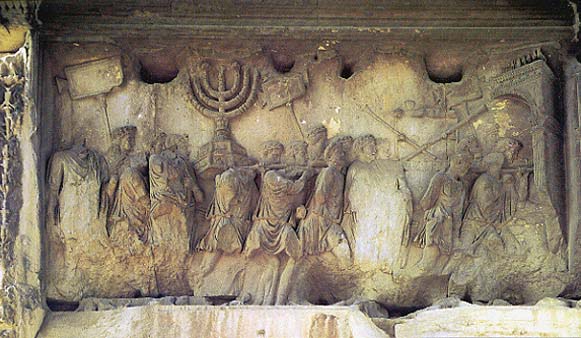
Coins struck during the Bar Kochba Revolt (132–135 A.D.) also show what are probably pairs of trumpets and two types of lyres. Like several other motifs on these coins, e.g. the lulav, etrog and the Temple facade, these instruments serve as reminders of the Temple service’s vanished glories.

Ivory endures, though not always well. Ivory horns, 026known in medieval Europe as olifants, have survived; for example, a lovely carved ivory horn dated to around 1,400 B.C. was found at Ugarit in Syria. Though parts of flutes and clarinet-type instruments made of ivory have surely survived, none has been identified so far among the diverse ivory objects reported from excavations in Israel.
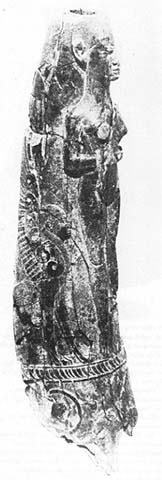
Pottery is another durable material which can be used to make musical instruments. In contemporary Israel we encounter the vase-shaped pottery drum (the Arab darabuqqah) almost everywhere. Surprisingly, excavations have not turned up anything which could be identified as a drum of the same type. Evidence from other Near Eastern areas infers that the darabuqqah began to be played in this region in the Middle Ages, at the very earliest. Excavations have yielded dozens of pottery rattles, ranging in date from before 1,000 B.C. to about 800 B.C. It appears that the pottery rattles fell into disuse when metal bells were introduced.
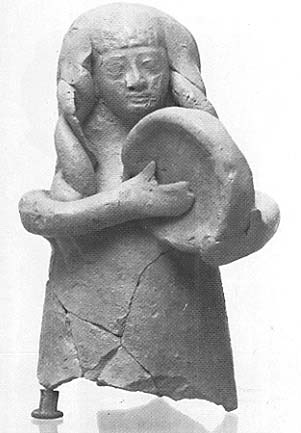
Both wind and percussion instruments, simple flutes, clappers, and the handles of rattling instruments such as the Egyptian sistrum, were often made from bone, a quite durable material. A now-famous bone flute was unearthed in the Jerusalem City of David excavations. Recently, I identified another bone flute fragment which excavators at Tel Dothan found nearly eighteen years ago. Both finds are from the Second Temple period (sixth century B.C.–first century A.D.). It now seems that many more flute fragments than those reported may have been uncovered in excavations; unrecognized for what they were, and taken for ordinary bones, they were probably thrown away with the rest of the “rubbish.” Nowadays, this is unlikely. A bone which shows signs of having been worked (by having, for example, drilled holes) will at least be recognized as an “unidentified object” and put in storage—which is what was done with the Dothan fragment. Two other such “objects” have been reported indirectly to this author, and attempts are being made to trace them.
The bone flute from the City of David apparently has all its finger-holes intact: four front holes, and two back holes for the two thumbs. Our musically trained readers will wonder what kind of scale such an instrument yields; unfortunately, we must disappoint them. Just as Arab shepherds today make their flutes with equidistant holes, so did the ancients. This means that the instrument yields a row of ascending/descending tones untuned to a particular scale. Western flutes, in contrast, have non-equidistant holes, and, consequently, one built-in tuning, used for all scales. This configuration of holes was a necessary adaptation of the instrument resulting from the introduction of musical 027harmony in the West. But in the Near East, melodic subtlety still reigns supreme. It is the player himself who makes the tuning while he plays, just as the City of David flutist did, by modifying his blowing and fingering.
As we have seen in the case of the bone flutes, it is very easy for an archaeologist to “miss” an ancient musical instrument in the course of excavation. This was almost the case in Sir Leonard Woolley’s 1927 excavation of the Mesopotamian royal tombs at Ur. When the 2,500 B.C. burial sites were being excavated, someone noticed two holes about 75 cm apart on the floor. Woolley was there—and he had an intuition. He told his workers to pour plaster of Paris into the holes. When the plaster had hardened, the surrounding earth was removed, and before the excavators’ eyes emerged the form of a large lyre. Over the centuries, the soil had settled into a tight packing around the instrument. The wooden body, the two arms, and the yoke had entirely vanished, but the soil packing had preserved the spaces which the vanished parts of the lyre had once filled. The two holes the excavators had spotted had been the tips of the arms. (For a picture of this reconstructed lyre, see “World’s Oldest Musical Notation Deciphered On Cuneiform Tablet,” BAR 06:05.)
Although archaeologists in Israel have not yet had the good fortune to come across such a great find, the musicologist must always hope and pray that no holes are left unfilled.
We need not rely solely on the material remains of instruments to reconstruct the musical environment of ancient Israel. There is also iconographical evidence. People making music were often depicted (despite what was previously assumed about the “force of the Second Commandment”) by a variety of means. Representations of musical events are important because they show how the instruments were played as well as portraying the circumstances in which music-making occurred.

Depictions of musical scenes often preserve evidence of dancing, music’s companion-art which is so difficult to 028portray. One example of particular artistry is a bronze bowl, engraved on its interior with three musicians and seven dancers. The bowl, found on Cyprus, is only five inches in diameter.

A very early depiction of a dancer was found among the graffiti scratched on some paving slabs in one of the lowest layers at Tel Megiddo, c. 3,000 B.C. The earliest representation of a stringed instrument known from any culture appears in an adjacent graffito which shows a man playing a stringed instrument. The instrument seems to be something between a harp and a lyre.

Other depictions can be observed on painted pottery. A procession of animals together with a lyre player was found on a vessel from Megiddo, dating from around 1,100 B.C.
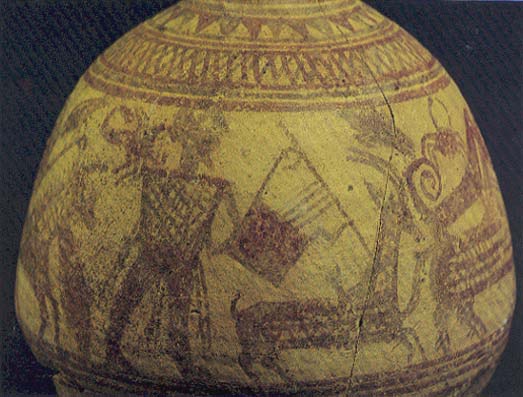
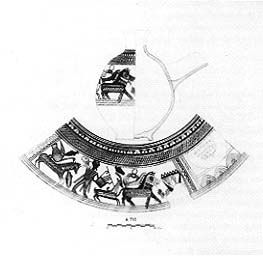
Mention should also be made of two other important finds: One is the ivory from Megiddo (slightly older than the painted vessel), engraved with scenes from the life of a king, including a lyre player at his banquet. The lyre player is seen from the left side, and that is why we do not see the strings continuing over the body of the instrument; we see only the back of the lyre. The other find comes from Kuntillet Ajrud. It is an informal depiction called a dipinto (“scribble-in-paint”) found on a pottery jar from the days of the Judean monarchy. Someone tried to paint a lyre player among other figures, but the details are not clear; moreover, the paint of these dipinti has almost faded away. If it were not for photographs which were taken immediately after the discovery, almost nothing could be understood today from the traces which remain.


Two other cases of fading paint are also regrettable, 029even though they come from a later, better-documented period. One is the depiction of a harp player and a double pipe player discovered among the frescoes found at the beginning of the century in the necropolis of Maresha (near Beth Guvrin). The frescoes date from c. 250–200 B.C. Luckily, paintings were made of the frescoes before they began to fade in reaction to contact with the open air. Also at the beginning of the century, a painted ceiling dating to the second century A.D. was discovered in a rock-cut dwelling (or tomb) at Petra. The original report stated that the painting showed the figure of the Greek god Pan (or alternatively—a monkey), playing “a flute.” In a photograph taken in 1906, the figure is already unrecognizable. A report from the 1950’s states that the Petra fresco had totally deteriorated from exposure.
Synagogue mosaics and some reliefs, such as the first century A.D. Arch of Titus relief mentioned above, may also augment our understanding of music in Israel. Most of these mosaics and reliefs are from the fourth–sixth centuries A.D. One of the most common depictions found in these art works is the shofar, or ram’s hoary, often banded with gold, a practice which soon afterward was discontinued.
Other representations are found on ivories (such as the one from Megiddo previously mentioned, and one from Tell el-Far’ah, south of Gaza). The so-called Phoenician bowls which, despite the name, were found mainly outside Phoenicia and date from the ninth–seventh centuries B.C., depict banquet scenes with little ensembles of musical players. Generally there is a lyre, a double pipe and a frame drum. Especially luxurious scenes may have two drummers or a row of additional dancers.
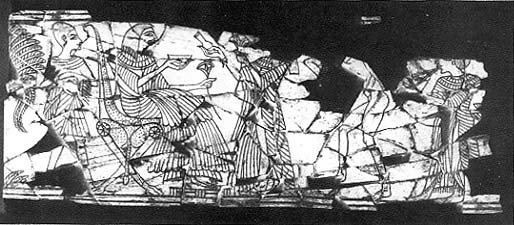
The most recently discovered witness to the content and configuration of a musical ensemble, and the first find in Israel, is from Ashdod. It is a pottery stand-cum-bowl, dating roughly to the tenth century B.C. Five figurines decorate the base. One plays the double pipe, 031another the lyre (of which only a remnant is preserved) and a third the frame drum. The fourth and fifth figures are less easy to interpret. Groups of pottery musician-figurines playing frame-drums, cymbals and double pipes were also found in Phoenician (or Phoenician-style) tombs from about the eighth or seventh century B.C.

Although all these representations comprise an immeasurable boon to our understanding of ancient Israel’s musical life, they must be interpreted very carefully. We must remember that they are not photographs. Many of the artistic styles do not strive for a great measure of realism; the scratchings and scribblings are often no more than that.

A full roster of all the musical artifacts from Israel would fill a large volume, which will, I hope, be produced in the not too distant future. We have presented here an overview of what has been found—a preview of the material upon which research can be built.
The interpretation of the artifacts is our most important 033task. It calls for a very careful analysis of Biblical and other written evidence in conjunction with what the excavations have yielded. The music-making of the ancient Israelites did not exist in a vacuum. There was a general “style” of the area, which one could term Greater Canaan, and there were particular choices, to adopt or reject, made by individual communities within that area. All this is a matter for separate discussion. It is clear, however, that we should no longer draw on Egyptian and Mesopotamian relics in order to understand music in ancient Israel.

The Bible has not come down to us with original illustrations. The artifacts have no inscriptions, as do many music scenes in Egypt which say that “this is lady X who plays the instrument Y.” As we compare archaeological finds with the names and descriptions of instruments in our sources—such as kinnor, nevel, and halil—we are slowly but certainly beginning to see before our eyes the forms of these ancient instruments.
Archaeologists are gradually recovering the remains of musical life from ancient Israel. More than three hundred remains of actual instruments and representations of musical scenes have been recorded. The dates of these items range from late pre-history to the Byzantine period, including a sizable number within the span from Biblical to Second Temple times, roughly 1,000 B.C. to the first century A.D. Not long ago, these were “The Finds That Could Not Be.” In the 1940’s and 1950’s, an astonishing “consensus of nonexistence” came about, through several influential publications. As late as 1957, one of these stated: “Of the […]
You have already read your free article for this month. Please join the BAS Library or become an All Access member of BAS to gain full access to this article and so much more.
Already a library member? Log in here.
Institution user? Log in with your IP address or Username
Footnotes
The Second Commandment states “You shall not make for yourself a graven image, or any likeness of anything that is in heaven above, or that is on earth beneath; you shall not bow down to them or serve them …” (Deuteronomy 5:8).
Although Biblical passages are quoted in their conventional English translations, the names of musical instruments have been modified by the author. For example, in 1 Samuel 10:5, the company of prophets is preceded by “nevel (large lyre) and tof (frame drum) and halil (double pipe) and kinnor (lyre). …” The conventional English translation is “psaltery and tabret and pipe and harp.” The translators’ terms, which have a generally medieval European historical background of their own, do not concern us here since our task is not to identify the “psaltery,” but, rather, the nevel. The issue is similar for all the other names of musical instruments. For the general classification of instruments and standard terminology, see C. Sachs, The History of Musical Instruments (New York, 1940), pp. 454–467. For the Biblical terms see B. Bayer, Encyclopedia Judaica, Volume 12, s.v. Music; History—Biblical Period (cols. 560–565).
Endnotes
C. H. Kraeling and L. Mowry, “Music in the Bible,” The New Oxford History of Music, I: Ancient and Oriental Music, ed. E. Wellesz (London, 1957), p. 295.
Ovid R. Sellers, “Musical Instruments of Israel,” The Biblical Archaeologist, Vol. IV/3 (Sept. 1941), pp. 33–47. Also in The Biblical Archaeologist Reader (I), ed G. E. Wright and D. N. Freedman (Garden City, N.Y. 1961), pp. 82–83.
For the inventory of finds (now much enlarged), see B. Bayer, The Material Relics of Music in Ancient Palestine and its Environs: An Archaeological Inventory (Tel Aviv, Israel Music Institute, 1963). A summary in English, with respect to the Biblical and Second Temple traditions, can be found in the first part of the central article, “Music,” of the Encyclopedia Judaica (Jerusalem, 1972).

